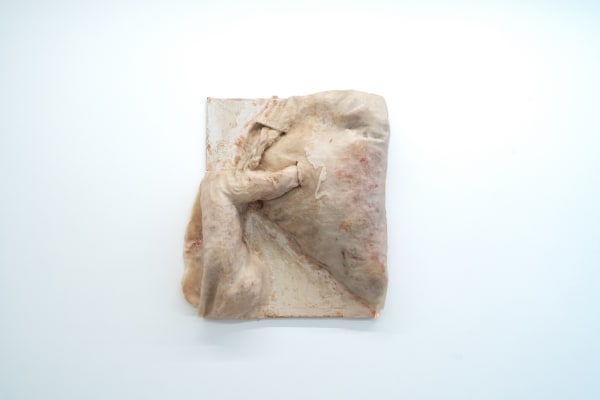"People are subject to two different impulses at the same time:
the terror that frightens them back and the attraction that
fascinates themand compels awe. The prohibition and the
transgression correspondthese two opposing impulses:
the prohibition deters, but the fascination tempts to transgress."
- Bataille: Eroticism, 68
Seeking the interface between carnality and the sacred, Anat Homm’s practice explores the essence of the duality of the human condition, exploring the co-existence of beauty and repulsion, the erotic and destructive and the boundaries of the corporeal. Through her representation of the body Homm explores humanity’s instinct to possess and to comprehend through our most primitive obsession: our own being.
The dominant thematic element of Homm’s work lies in an interest in sacred transience and the sublime aspects of the carnal. Within this, Homm’s practice places a particular emphasis on the vulnerability of our continuance as symbolized by the fragility of our physical states. To be wounded demands exposure, to be unveiled, to be removed from a protectionist shroud. Thus, the macabre beauty of the punctuated flesh and exposed entrails is at once horrifying as it scratches at our need for self-preservation and thus reminds us of the fatality of existence and our inefficacy to defeat the inevitable. Synchronically, this transience makes it dangerous to feel, with the human condition containing a great potential for pain. In this sense, our base instinct of fear concerning our own lives can be extended to a vulnerability with regards to our other mortal attachments that exist in an equally precarious state of permanence.
Alongside the interest in the vulnerability of transience, Homm’s work explores the erotic undertones and tensions between our carnal and spiritual relationship with the flesh. Within this she explores the transgressive boundary between pleasure and pain, with an openness to eroticism as extraneous to morality. The co-existence of pleasure and pain in the objects of our desire creates a resulting turmoil that is what makes us so terrifyingly human:
“Only a fool would go to a fight to the death and fall in love with both combatants. But just imagine the intensity with which every second of the fight will burn into him. And at the moment of death and survival at the end, the fool will fall to the ground in pain and cry out in bliss. And then he will laugh, because he has no other choice in the face of this incongruity within himself. And he will become addicted to this laughter, because he has never felt more alive and more human than at this moment.”
– Anat Homm
Hence, co-exists the two combatants within the human objects of our lust. For the object of our desire must change and morph, always abandoning us either through lack of reciprocity or death. Furthermore, the erotic fixation with the flesh of the desired conveys a concupiscence for intimacy. The language in relation to the flesh is thus important in so far as nakedness, invasion, under the skin, open wounds, all connote either physical or emotional propinquity.
Homm’s practice works with and contradicts the limits of the figurative; with superimposed bodies and anamorphic compositions that emerge and disintegrate within themselves. The aspect of annihilation as an innate existential fear that exists simultaneously with the contradiction of the human actuation for destruction, is inherent to Homm’s work. From an aesthetic and compositional perspective, the anthropomorphic objects relate in homage to The Fall of the Damned (1620) by Peter Paul Rubens. The intertwined nature of the figures and the leaning of descent through weighted structures mirrors the intertwined bodies and demons descending into Hell upon God’s final judgement.
In conjunction with this, Homm’s interest in The Fall of the Damned can be read further to explore the materialism and modes of production within her work that reflect on humanity’s fixation on destruction. In this regard, the original painting by Rubens was subjected to acid being thrown over the piece in 1959 by an assailant who claimed in a letter to a newspaper at the time that his act was “an explosion of spirit” and that the acid “relieves one from the work of destruction”. The act can be read as a form of performative destructivism that exists continuously within society’s relationship to culture with evolving contextual socio-political motivations. Relating the history of The Fall of the Damned to Homm’s work leads us into the thematic and material elements through which she explores humanity’s fragile fascination with destruction. In this regard, the manner in which the works are created lends itself to a visceral interpretation: cutting, clawing, tearing, melting and dissecting. With each of these gestures a human trace is left upon the figure leading them to bear a physical trace of the materiality of a human’s act of destruction. Similarly, the compositions themselves, with wounds and internal organs exposed, enacts a demolition of the subject which is both physical and metaphorical.
This element of the destructive is also a constituent aspect of the erotic with violence being an inextricable aspect of our carnal desire. The phrase in relation to desire of “getting under the skin” with its sense of intrusion and disturbance creates a similar sensation to the touching of a wound. The inherent violence stemming from this does not dissuade the mind from the transgressive imagining of the sensation were one to perform it. Additionally, the execution of our carnal desires is ultimately violent in consummation, with our conception and entrance into existence being inseparable from the potential destruction of the body of one being to birth another.











